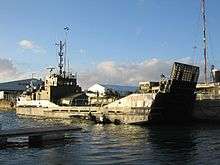Royal Corps of Transport
| Royal Corps of Transport | |
|---|---|
|
Royal Corps of Transport regimental badge | |
| Active | 1965–1993 |
| Country | Worldwide |
| Allegiance |
|
| Branch |
|
| Garrison/HQ | Buller Barracks, Aldershot |
| Nickname(s) | Troggs, Rice Crispie Tasters, Rickshaws Cabs and Taxis,The Waggoners |
| Motto(s) |
Nil sine labore ("Nothing without labour")[1] |
| March | Wait for the Wagon |
The Royal Corps of Transport (RCT) was a British Army Corps established to manage all matters in relation to the transport of men and materiel for the Army and the wider Defence community. It was formed in 1965 and later in 1993 was disbanded to allow its units and trades to be amalgamated into the Royal Logistic Corps. The Depot and Training Regiment RCT was at Buller Barracks in Aldershot.
History
Its earliest origins link the RCT to the Commissariat, a civilian organisation responsible directly to the Treasury, which provided food and supplies to Oliver Cromwell’s New Model Army. However, the very first military transport unit, the Corps of Waggoners, was formed in 1794. This evolved into the Royal Waggon Train which served throughout the Napoleonic Wars, notably at the Battle of Waterloo.
Following its disbandment in 1833, there were a number of short-lived organisations such as the Military Train and the Land Transport Corps, but it was not until the formation of the Army Service Corps in 1899 that transport and supplies became a well organised permanent body.
At the outbreak of the First World War the Army Service Corps numbered 6,500 men, by 1918 this number had grown to 325,000 men. In recognition of the Army Service Corps’ contribution to the war effort of 1914-1919 the Corps was granted the ‘Royal’ prefix and was thus known as the Royal Army Service Corps.
The Royal Corps of Transport
Was formed in 1965 from the transport (land, water and air) elements of the Royal Army Service Corps (RASC) and the movement control element of the Royal Engineers (RE). The Royal Army Service Corps’ functions of supply and transport were separated. The RCT became responsible for transport whilst supplies became the responsibility of the Royal Army Ordnance Corps.[2] In 1993, following the Options for Change review, the Royal Logistic Corps (RLC) was formed by the amalgamation of The Royal Corps of Transport, Royal Army Ordnance Corps, Royal Pioneer Corps, Army Catering Corps, and Postal and Courier elements of the Royal Engineers.[3]
Trades

The Royal Corps of Transport consisted of a number of different specialist trades. These included:[4]
- Driver was the primary trade of the RCT and as such private soldiers held the rank 'Driver'.
- Driver (Responsible for General Duties and Driver tasks).
- Driver Radio operator
- Driver Tank Transporter
- Driver Air Dispatcher
Although in conversation the 'Driver' element was often dropped from these other Driver roles, even though the rank abbreviated as Dvr remained.
Clerical trades also completed basic driver training before going on to specialise
- Clerk - Working within RCT Squadrons.
- Movement controller previously referred to as Traffic Operator
Port and Specialised Support Trades, Port and Maritime specialists
Again basic driver training was required
- Driver Port Operator
- Driver Railwayman (79 Railway Squadron RCT)
- Mariner (Seaman)
- Marine Engineer
- Pilot - Hovercraft - for a very short period. Pilot was not really a trade but an appointment
RCT personnel served in additional roles
- Staff car Driver could be carried out by any driver trade and additionally by those that carried out the Staff car Driver's course at the Army School of Mechanical Transport - (Later Defence School of Transport).
- Airborne Forces as a Parachutist but stayed in trade, so not for sea, port and railway trades. N.B. Parachutist was never a trade in the RCT. However 63 Parachute Squadron RCT, was part of the Airborne Bde.[5]
- Royal Marines (Commando Logistic Regiment) Having completed the 'Army Commando Course'
- Special Duties Teams in Northern Ireland
- Master Driver
Additional Officer Information
- The RCT provided the first Service Support Officer to command 22 SAS (Brigadier Andrew Massey RCT, Later SAS, CO 22 SAS 1984–87)
Andrew Christopher Massey, soldier: born Carlisle, Cumberland 18 April 1943; MBE 1979, OBE 1987; Commanding Officer, SAS 1984-87; Deputy Director, Special Forces 1990-91, Commandant, RCT Training Centre 1992-93; married 1977 Annabelle Cunningham (one son, one daughter); died Hereford 19 August 1998. [6]
References
- ↑ "The Royal Logistic Corps and Forming Corps". The Royal Logistic Corps Museum. Retrieved 1 March 2014.
- ↑ "Royal Army Service Corps & Royal Corps of Transport Association". Retrieved 17 May 2014.
- ↑ "History and scope of the Regiment". Royal Army Service Corps & Royal Corps of Transport Association. Retrieved 17 May 2014.
- ↑ "Royal Corps of Transport". ARRSEPedia. Retrieved 1 March 2014.
- ↑ "63 Parachute Squadron RCT". paradata.org.uk. Retrieved 1 March 2014.
- ↑ Arthur, Max (14 September 1998). "Obituary: Brigadier Andrew Massey". The Independent. Retrieved 1 March 2014.
External links
- "Royal Army Service Corps and Royal Corps of Transport Association".
- "The [unofficial] site of the Royal Corps of Transport".
- "Website of the Air Despatch Association".
